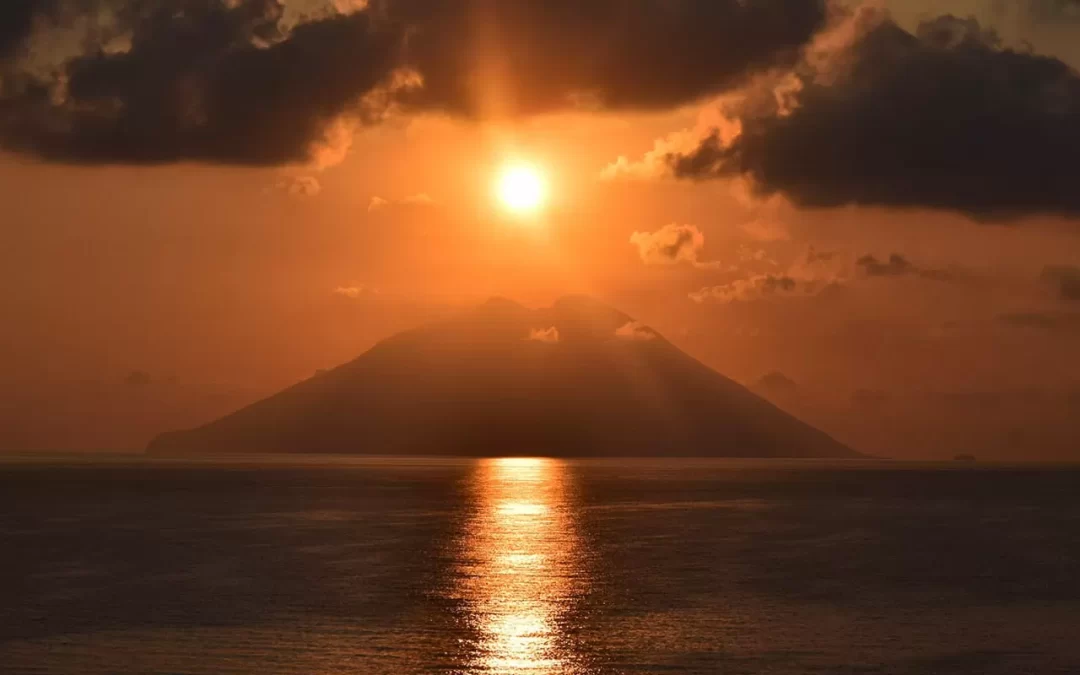In Sicily, there is not only the famous volcano Etna, but also the smaller Stromboli. Two wonderful active volcanoes, but with profound differences.
- Age: while Etna was born about 570.000 years ago, Stromboli is much younger, being only about 160.000 years.
- The heightof the two volcanoes also has a significant difference: while Etna dominates eastern Sicily with its height of 3,357 metres (official measurement from July 2021), Stromboli has a height of only 926 metres.
- Finally, they differ in their activity: Etna is often topped by a cloud of smoke, while Stromboli has continuous eruptions, from which the term strombolian activity comes.
The eruptive spectacle of Stromboli
Stromboli is a permanent active volcano, its eruptions are regular and continuous. Every 10-20 minutes it throws in the air magma and gas, pushing it up to 200 meters high. This show is clearly visible from far away, so far that was once used as a lighthouse for navigators to indicate them the way.
More than this explosive activity, from tonight there is also a lava flowing river that in just a few hours reached the sea along the “sciara del fuoco“. This is how the very steep side of the volcanic cone gets called. This cone consist of lava, lapilli and volcanic scoria. Most of the lava during eruptions gets poured from the top crater at 750 meters high, along the sciara until it reaches the Tyrrhenian sea.
The summit of the Stromboli volcano towers over the north-west side of the island. The volcano’s regular eruptions pose no danger to the population, as Sciara del Fuoco is enclosed between two rocks. Explosive and eruptive activities are accompanied by strong tremors.
The island with its 6 sisters
Stromboli island is part of the Sicilian archipelago of the Aeolian Islands, situated in the Tyrrhenian sea at north of Messina. It is the northern island of them all, 7 in total and it has a surface of 12,62 square km, and about 570 inhabitants, but from spring to autumn the island attracts many tourists from all over the world.
The island is famous and inhabited from ancient times, thanks to its fertile volcanic soil. The economyof Stromboli island is mostly based on typical Mediterranean cultivation, such as olives, capers, figs and peaches. Special attention goes to the Malvasiagrape, cultivated in gardens terrace style.
Malvasia is a grape variety that originated in Greece and was already cultivated on the island of Malta in the Middle Ages. In the 13th century it was imported to Italy by the Venetians and spread throughout the territory, taking on different characteristics. On Italian territory there are 17 different types of Malvasia vines. They are white or black grapes. The white Malvasia of the islands of Lipari is very popular.
The grapes are not only made into an excellent dry and fragrant white wine, but also into the eponymous liqueur or sweet white wine, which goes perfectly with typical Sicilian sweets, but also with fresh summer dishes such as ham and melon or cheese with honey and pears.
The island of Stromboli, like the other islands of the archipelago, can be reached by ferries from Naples, Milazzo, Messina, Reggio Calabria, Vibo Valentia and Tropea.
Stromboli excursion destinations
There are also other beautiful destinations that can be reached by boat from Stromboli, such as the island of Panarea, where there is certainly more life, or the nearby village of Ginostra, or the island of Strombolicchio, an extinct volcano about 1.5 km from Stromboli. Strombolicchio has an area of only 7,620 square metres and is only 49 metres high. A lighthouse powered by solar energy was built there in 1925. There is neither water nor arable land on the island, but there is an endangered vegetation species, the Granata Rupicola (Bassia saxicola) and a protected animal species, the Aeolian lizard (Podarcis raffoneae).
